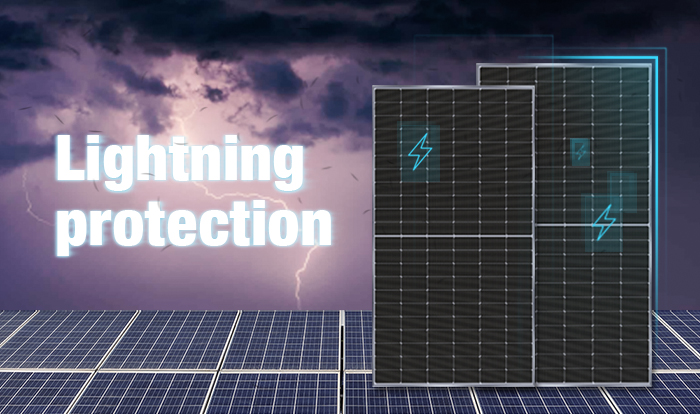
In the sunny region, industrial and commercial rooftop solar systems are sprouting up, providing economic benefits to businesses while also contributing to environmental conservation. However, solar PV systems face significant safety threats during lightning and thunderstorms. How to ensure the safe and steady operation of solar systems in lightning storms has become a pressing issue in the industry. In this paper, we will go over in-depth commercial and industrial roof solar system lightning protection concerns in order to provide a realistic lightning protection guide to relevant organizations.
1. Create a safety line of defense and raise lightning awareness.
Lightning protection for industrial and commercial rooftop solar systems is more than just an equipment installation; it reflects security awareness. Enterprises should fully comprehend the possible threat of lightning to solar systems and incorporate lightning protection measures into daily operations and maintenance management. By improving the staff's understanding of lightning dangers and their capacity to deal with them, a solid safety line of defense may be built.
2. The likelihood of lightning strikes can be reduced by prudent planning and architecture.
During the development and layout stages of the PV system, lightning protection should be thoroughly considered. Choose a good spot, arrange your components optimally, and take other precautions to lessen the likelihood of a lightning strike. Simultaneously, lightning protection requirements, such as the implementation of suitable lightning protection devices and protocols, must be included in the system design to guarantee the system's secure and reliable operation during lightning storms.
3. Enhance the system's protective capabilities by selecting top-notch lightning protection devices.
The effectiveness of lightning protection in the solar system is directly correlated with the equipment selection process. In order to keep operations running smoothly during lightning storms, businesses should choose lightning protection equipment with a good reputation and a track record of reliability. Simultaneously, routine inspections and maintenance of lightning protection equipment are necessary to keep it in top operating condition and enhance the system's total protective capacity.
4. For faster dissipation of lightning energy, strengthen the grounding mechanism.
A solar system's grounding system is a crucial component of its lightning protection measures. By more rapidly discharging lightning energy into the ground, a better grounding system reduces damage to the system. The grounding system's design and construction must adhere strictly to the applicable operational criteria to guarantee the grounding resistance is sufficient to improve the system's lightning performance.
5. Improve monitoring and early warning, prompt response to the threat of lightning.
With the advancement of technology, sophisticated monitoring and early warning systems in photovoltaic lightning protection become increasingly crucial. Lightning monitoring equipment is installed, early warning mechanisms are established, lightning activity is monitored in real time, and lightning risks are detected and responded to in a timely manner. Enterprises should fully utilize these modern technologies to improve the monitoring and early warning of the PV system, ensuring that lightning weather can respond swiftly and efficiently.
6. Build emergency plans to boost reaction capabilities.
In addition to the aforementioned procedures, businesses should have a comprehensive lightning emergency plan. The plan should specify the lightning weather reaction procedures and processes, such as personnel evacuation, equipment shutdown, troubleshooting, and other details. Regular drills and review of the plan's performance can increase the staff's capacity to deal with lightning weather, ensuring the PV system's safe and steady functioning.
To summarize, lightning protection for industrial and commercial rooftop PV systems is a methodical effort that must begin with several components. A solid safety line can be built to ensure the safe and stable operation of green energy by increasing awareness of lightning protection, rational planning and layout, selecting high-quality lightning protection equipment, perfecting the grounding system, strengthening monitoring and early warning, and establishing emergency plans, among other measures. We believe that as technology advances and applications expand, lightning protection for industrial and commercial rooftop photovoltaic systems will become more flawless and effective.






